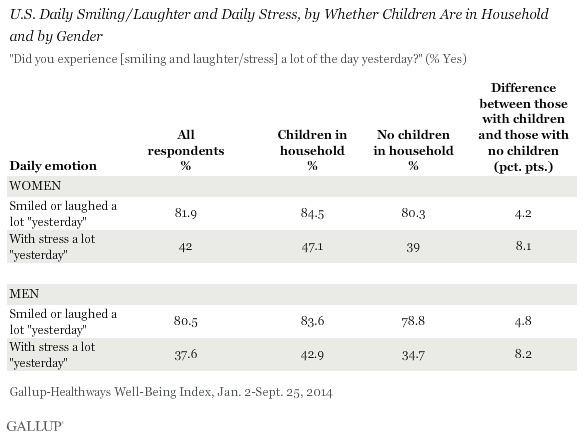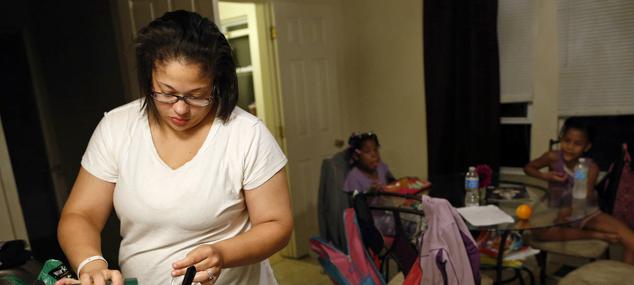Story Highlights
- Adults with children at home are more likely to have stress.
- These adults also are more likely to smile and laugh a lot.
- These patterns are similar for men and women.
WASHINGTON, D.C. -- American adults who have children younger than 18 at home are more likely than adults who don't live with children to say they smile or laugh a lot on any given day, 84.1% vs. 79.6%. At the same time, by an even greater margin -- 45.1% vs. 36.8% -- adults with children at home also experience greater stress, according to the Gallup-Healthways Well-Being Index.

These findings are based on 131,159 interviews with American adults, aged 18 and older, including 36,043 adults who reported having a child under age 18 living in the household. Interviews were conducted from Jan. 2-Sept. 25, 2014, as part of the Gallup-Healthways Well-Being Index, which organizes well-being into five elements: purpose, social, financial, community, and physical.
Daily emotions such as smiling/laughter and stress are affected by all five elements of well-being. The 8.3-percentage-point gap in reports of daily stress between those with and those without children under 18 at home is nearly double the 4.5-point gap in reports of smiling and laughter. On a relative basis, then, it appears children do more to boost negative than positive emotions. These patterns also hold true after controlling for age.
Differences in Emotions Similar in Both Women and Men
The relationship between children in the household and daily emotions is similar among men and women. Although women as a whole report more stress than men on any given day, the difference in stress rates between those with and those without children is almost identical for each gender -- around eight points. Likewise, daily smiling and laughter, which men and women report similarly, is enhanced by comparable levels for each gender.

Bottom Line
As many parents will attest, raising children is a task filled with great joys as well as great challenges. This extends to emotional outcomes, which are a part of well-being. The parenting experience of having children living at home is filled with many moments of joy, typically driven by love and buttressed by the satisfaction that comes with children's growth and successes as students, artists, athletes, friends, and citizens -- inside and outside the home.
Parenting, in turn, also comes with many challenges that can catalyze stress on a daily basis. These range from managing normal behavioral struggles about mealtime, household routines, and homework, along with loss of sleep, to more serious issues faced by many parents -- including teen rebellion, addressing special needs, eating disorders, peer issues, substance abuse, and self-injury. The stress associated with grappling with these issues may be further magnified for the parent upon separation or divorce, especially for women.
Ultimately, the simultaneous increase in positive and negative emotions when one lives with children is something many parents will invariably encounter. That these elevated emotions are common to women as well as men underscores the shared parenting that occurs in many families, and can play a part in helping spouses recognize a shared set of experiences in this role.
Survey Methods
Results are based on telephone interviews conducted as part of the Gallup-Healthways Well-Being Index survey from Jan. 2-Sept. 25, 2014, yielding a sample of 131,159 adults, aged 18 and older, living in all 50 U.S. states and the District of Columbia, selected using random-digit-dial sampling. Of this sample, 64,468, 46,525, and 18,738 were with all men, men without children younger than 18 in the household, and men with children younger than 18 in the household, respectively, while 65,673, 48,220, and 17,305 were with all women, women without children in the household, and women with children in the household, respectively.
For results based on the sample sizes noted above, respondents for each gender will have a maximum expected error range of about ±0.5 percentage points, while respondents for each gender without children at home will have a margin of error of about ±0.5 percentage points and respondents for each gender with children at home will have a margin of error of about ±0.9 percentage points. Each sample of national adults includes a minimum quota of 50% cellphone respondents and 50% landline respondents, with additional minimum quotas by time zone within region. Landline and cellular telephone numbers are selected using random-digit-dial methods.
Learn more about how the Gallup-Healthways Well-Being Index works.

